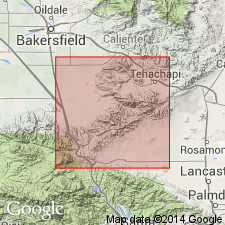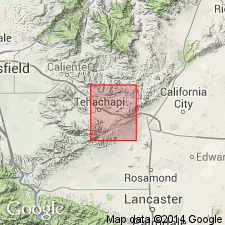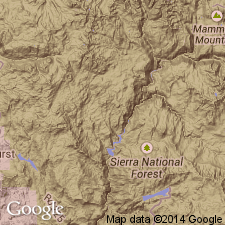
- Usage in publication:
-
- Kinnick formation*
- Modifications:
-
- Named
- Biostratigraphic dating
- Dominant lithology:
-
- Tuff
- Agglomerate
- Shale
- AAPG geologic province:
-
- Sierra Nevada province
Summary:
Named from Kinnick Ridge, north of confluence of Cache, Oil, and Sand Creeks, Kern Co, CA. [Name Kinnick formation first used by Buwalda (1934) in abstract]. Type section designated at unconformity north of Cache, Oil, and Sand Creeks (southwestern corner of sec.11 T32S R34E, thence northward through saddle west of Hill 5015, Mojave quad in NW/4 sec.34 T31S R34E). Exposed over wide area west of Cache Creek from Monolith northward for 6 or more mi. Consists mainly of stratified green basic volcanic tuffs, largely ash beds with some coarse agglomerates; upper part consists of gray, sandy shale with, locally, white freshwater diatomaceous beds and cherts and some basic lava flows. Is not less than 1500 ft thick. Unconformably overlies Witnet formation (new); conformably (?) underlies Bopesta formation (new). Age is middle Miocene based on Phillips Ranch vertebrate local fauna found in shales of upper part of unit.
Source: GNU records (USGS DDS-6; Menlo GNULEX).

- Usage in publication:
-
- Kinnick Formation*
- Modifications:
-
- Revised
- AAPG geologic province:
-
- Sierra Nevada province
Summary:
Kinnick Formation is restricted downward to advantage of overlying Bopesta Formation. Type section designated from contact with underlying Witnet Formation at junction of Cache and Oil Creeks in NW/4 sec.14 T32S R34E northward about 0.5 mi to base of overlying rocks in SW/4 sec.11 T32S R34E, Kern Co, CA. Age given as middle Miocene.
Source: GNU records (USGS DDS-6; Menlo GNULEX).

- Usage in publication:
-
- Kinnick Formation
- Modifications:
-
- Overview
- AAPG geologic province:
-
- Sierra Nevada province
Summary:
Principal reference section of Michael (1960, unpub. Master thesis) designated as lower Horse Canyon and on ridge to west [from sec.14 T32S R34E, northward to sec.34 T31S R34E, Kern Co, CA] which is similar to type section of Buwalda and Lewis (1955). Ten lithologic members are described and mapped. Is over 1000 ft thick. Member 7 has isotopic age of about 17.6 Ma (Evernden and others, 1964). No fossils occur in Kinnick Formation as here restricted. Age given as early Miocene.
Source: GNU records (USGS DDS-6; Menlo GNULEX).
For more information, please contact Nancy Stamm, Geologic Names Committee Secretary.
Asterisk (*) indicates published by U.S. Geological Survey authors.
"No current usage" (†) implies that a name has been abandoned or has fallen into disuse. Former usage and, if known, replacement name given in parentheses ( ).
Slash (/) indicates name conflicts with nomenclatural guidelines (CSN, 1933; ACSN, 1961, 1970; NACSN, 1983, 2005, 2021). May be explained within brackets ([ ]).

